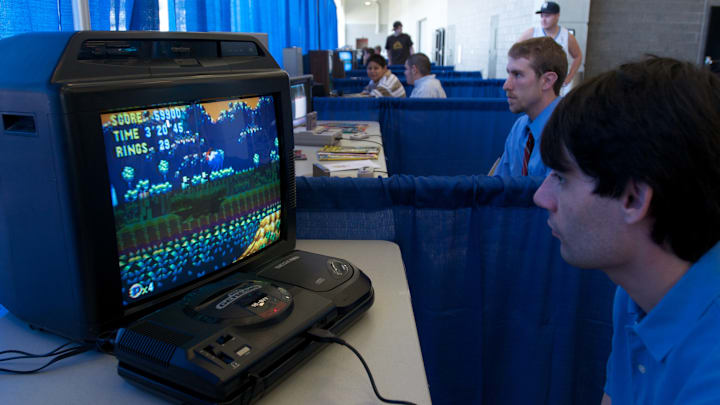Streaming entertainment may seem like a very 2000s ambition, but embers of it began stirring all the way back in 1993, when video game giant Sega announced the Sega Channel—a subscription service that allowed gamers to call up video game titles on demand.
The Japanese-based console manufacturer was an unlikely contender to unseat Nintendo as the world’s leading game brand, with the two locked in a market war reminiscent of Coke vs. Pepsi. Nintendo had brand loyalty, stars like Mario, and their advanced Super Nintendo; Sega was marketed as the hip alternative for older kids, with its Genesis system promoted through irreverent ads ("Genesis does what Nintendon't") and boosted by the popularity of Sonic the Hedgehog. By 1993, Sega had earned a hard-won 45 percent of the U.S. video game market, putting it in a virtual dead heat with Nintendo.
In line with their progressive attitude, Sega wanted to be the first to launch a truly interactive television channel.
Channel 99
While their approaches to the game business varied, both companies perceived the video rental market as a threat. Thanks to the proliferation of video stores in the 1980s and '90s, gamers could rent titles rather than buy copies outright for $40 to $60. Nintendo took an aggressive stance, attempting to lobby for laws prohibiting game rentals. When that failed, Nintendo sued Blockbuster Video in 1989 on copyright grounds for photocopying game manuals. (Blockbuster acquiesced and began using third-party manuals.)
Sega’s approach to game sampling was more pragmatic. They knew players were growing less likely to pay a high sticker price for a game they weren’t sure they were going to like. “The audience for video games is very sophisticated,” Ellen Van Buskirk, director of marketing services for Sega of America, told the South Florida Sun-Sentinel in 1993. “They won't buy a game unless they know it's worth playing.”
Sega’s solution was the Sega Channel, a portal reachable via cable systems that was tested in Florida markets that year. For $12 to $19 a month, subscribers could access the service through their Sega Genesis, which would be routed to their cable converter box through the use of a cartridge modem. Once on the service, players could select a game from a library of 50 to 100 options, download it to the cart, and then play it just as they would any store-bought title. The selection was usually rotated monthly.

For cable companies, the investment was minimal. While they had to absorb the cost of the cartridge ($100 to $125 per user), the only other special equipment needed was a circuit board that could receive a satellite signal. (Some cable companies charged a minimal "installation fee" to get users up and running.) Cable giants TCI and Time-Warner were early supporters, giving Sega a solid launching pad for the service.
There were some asterisks. While titles would load in just about a minute, they weren't permanently stored on the cartridge. Powering the device off would effectively erase the data. If Sega thought a title had potential to be a big seller, they might make only a few levels available on the Channel as part of its “Test Drives” category or take it down once it reached stores. Most games, however, were playable in full—a bargain for gamers who wanted variety.
System Error
The Sega Channel began its nationwide rollout in 1994 and into 1995, at which point it was available in 200 cable systems and was accessible to over 10 million households. Some operators reported having a waitlist for installing the equipment needed.
Once everything was hooked up, gamers could call up titles like Sonic, Earthworm Jim, Zombies Ate My Neighbors, Skitchin’, and dozens of others. Owing to the selection, users could also sample games they may never have picked up otherwise—like My Little Pony.
For parents, the cost of the monthly subscription wasn’t as much of a concern as how much time the Sega Channel could devour. One parent bemoaned the fact that her child was tuned into the Sega Channel for 80 percent of their television time. (Parents could, however, restrict access to games with mature ratings with the use of a PIN code.)
If Nintendo was concerned the Sega Channel could give Sega a market advantage, they didn’t publicize it. “We have been looking at something like this since 1988,” Nintendo spokeswoman Perrin Kaplin told the Sun-Sentinel. “We've rejected something very similar because we think ultimately it will hurt retailers.” (While Nintendo stuck to that philosophy at the time in the States, it did market Satellaview, which allowed for game downloads by satellite, in Japan between 1998 and 2000.)
Despite enthusiasm from players, the Sega Channel never reached the heights its creators expected. At its peak, it boasted just 250,000 subscribers, well below the tens of millions of users of today’s streaming services. Its waning popularity coincided with Sega’s overall decline: The Genesis was eventually overpowered by systems with superior hardware, and the company’s subsequent Saturn and Dreamcast consoles failed to make waves. The company was soon losing market share to newcomers like Microsoft’s Xbox and the Sony PlayStation. When the Genesis fell into obsolescence, so did the Sega Channel; it was discontinued by Sega in 1998.
But the fact that Sega was outpaced shouldn't minimize that the company was well ahead of its time. When the Sega Channel gained steam in 1995, just 14 percent of U.S. households had internet access (42 percent of adults hadn’t even heard of the internet). Now, 85 percent of households have some form of broadband internet service, and Xbox's streaming Game Pass program touts 25 million users. Sega Channel users were getting a glimpse into the future of entertainment without knowing it—and much like its speedy mascot, the company may have simply been moving too fast for its own good.
